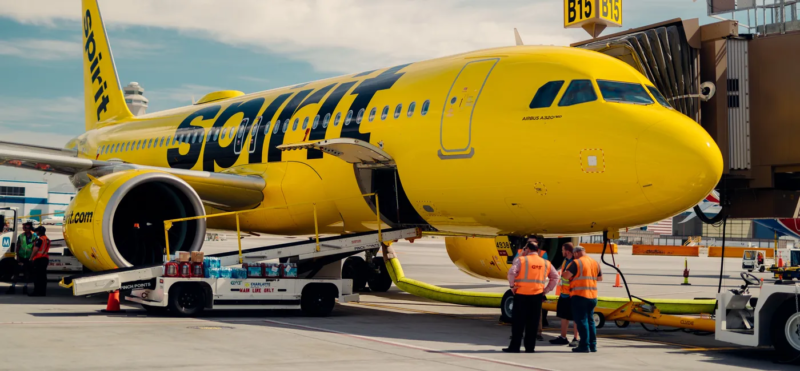Who Is Buying Spirit Airlines’ Fleet Amid Bankruptcy Risk?

Spirit Airlines, the ultra-low-cost carrier known for its bright yellow jets and bare-bones fares, is facing renewed financial turbulence just months after emerging from Chapter 11 bankruptcy. In a recent regulatory filing, the airline warned of “substantial doubt” about its ability to continue operations into 2026. To raise cash and streamline its business, Spirit has begun selling off a significant portion of its fleet—23 Airbus A320 and A321 aircraft—for $519 million.
The buyer is GA Telesis, a Fort Lauderdale-based aerospace asset manager and leasing firm. The acquisition aligns with GA Telesis’s strategy of fleet leasing, parts and maintenance services, and strategic resale. Some of the aircraft may be leased to other carriers operating short- to medium-haul routes, while others could be disassembled for parts or used in maintenance, repair, and overhaul operations.
This sale is part of Spirit’s broader restructuring plan aimed at reducing its $1.6 billion debt and improving liquidity by $225 million. However, the consequences are significant. Spirit’s overall flight capacity is expected to shrink by 20 percent in the fourth quarter of 2025, with further reductions likely into 2026. The airline also plans to furlough 270 pilots and downgrade 140 captains to first officers, aligning staffing with reduced flight volumes.
Frontier Airlines, JetBlue, United and Delta, facing delays in acquiring new aircraft (especially Boeing’s 737-10 and -7), could be interested in Spirit’s A320 series jets. American Airlines also has a large A320 fleet and could be interested in expanding it further. There’s also potential for resale to emerging airlines in Latin America, Africa, or Southeast Asia, where demand for mid-life Airbus jets remains strong. Spirit’s relatively young fleet, delivered between 2014 and 2019, makes it especially attractive to secondary markets.
The legal framework for the fleet sale falls under Section 363 of the U.S. Bankruptcy Code, which allows companies in bankruptcy to sell assets with court approval. The U.S. Bankruptcy Court for the Southern District of New York authorized the sale in December 2024. Under this provision, GA Telesis receives the aircraft free of liens, and any creditor claims attach to the proceeds of the sale rather than the aircraft themselves. Spirit also received approval to execute sale-and-leaseback deals for four A321neo aircraft with JSA International.
In addition to aircraft, Spirit may consider selling gate capacity and route rights, which could attract interest from competitors like Frontier Airlines or JetBlue. However, previous merger attempts with both carriers failed due to regulatory and financial hurdles.
Silver Airways’ Exit
Meanwhile, another Florida-based airline has quietly exited the stage. Silver Airways, a regional carrier specializing in short-haul, low-volume routes, has ceased operations and entered Chapter 7 liquidation. The only qualified bid for its assets came from Argentum Aviation, a Florida-based holding company backed by Wexford Capital. Argentum offered $5.775 million for Silver’s fleet of eight ATR turboprops, FAA and DOT certificates, and gate leases. The company plans to relaunch operations under the name Argentum Airways, focusing on Florida-Bahamas routes and potentially expanding into Alaska. The plan includes basing an ATR 42-600 turboprop in Anchorage and launching regional flights in late 2025. A second ATR aircraft is also planned for deployment before the end of the year.
Interest in Silver’s assets was limited, largely due to its $500 million debt load and deteriorated asset value. Other potential buyers, such as regional carriers like Cape Air or Southern Airways Express, and leasing firms specializing in turboprops, ultimately passed on the opportunity. Private equity and hedge funds may still cherry-pick assets for resale or repurposing, but the bankruptcy auction drew no qualified bids beyond Argentum’s offer.
The situations facing Spirit and Silver highlight the fragility of low-cost and regional airline models in a post-pandemic environment. Rising operational costs, shifting consumer expectations, and failed merger attempts have eroded margins and left carriers vulnerable. Spirit’s fleet sale may buy time, but whether it can reinvent itself and regain stability remains uncertain. Silver’s collapse underscores the challenges smaller carriers face in maintaining profitability amid inflation, maintenance delays, and lost partnerships.
As the aviation industry continues to evolve, asset sales, consolidation, and strategic downsizing appear to be the new normal. Whether these moves signal a rebirth or a slow fade for Florida’s airline sector remains to be seen.
Related News: https://airguide.info/?s=Spirit+Airlines, https://airguide.info/?s=silver+airways
Sources: AirGuide Business airguide.info, bing.com, visaverge.com
